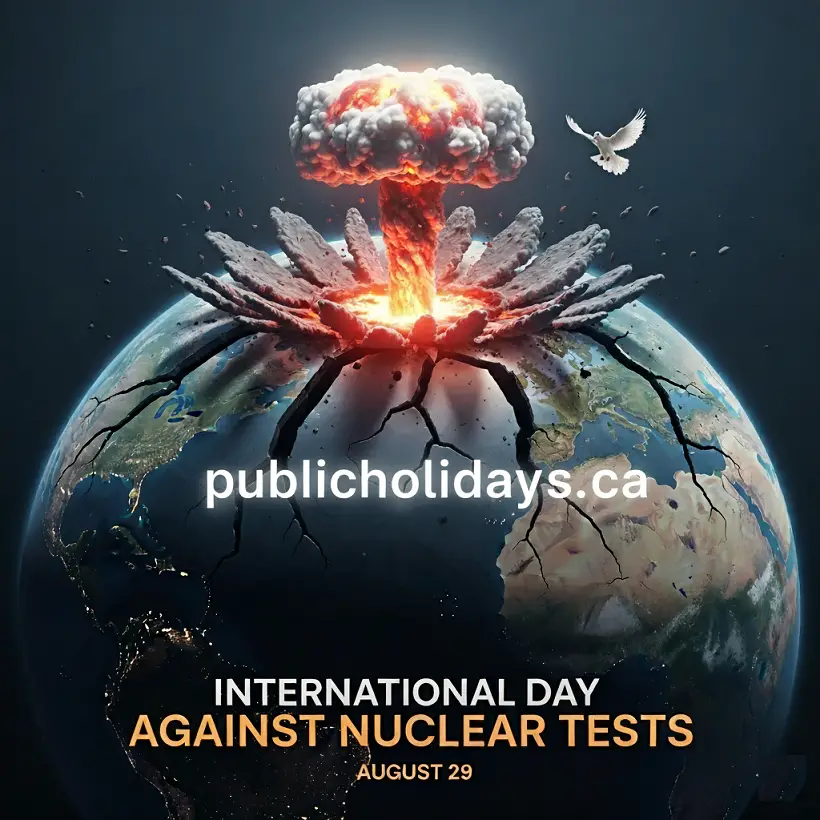The International Day Against Nuclear Tests – August 29

What Is the International Day Against Nuclear Tests?
Observed annually on August 29, the International Day Against Nuclear Tests focuses global attention on the humanitarian, environmental, and geopolitical harm caused by nuclear weapons testing. First recognized by the United Nations General Assembly in 2009, the day amplifies a straightforward goal: a world where all nuclear tests are banned and the risk of nuclear escalation is reduced.
Core Message
Prevent future harm by ending nuclear testing everywhere, for all time.
Who Leads
Governments, NGOs, scientists, survivors, and the UN system collaborate to advance nuclear disarmament.
Why It Matters
Testing leaves long-term health and environmental damage, and undermines global peace.
History & Significance: Why August 29?
The date honors the closure of the Semipalatinsk Nuclear Test Site in Kazakhstan on August 29, 1991. Over decades, the site saw hundreds of tests, leaving lasting impacts on nearby communities and ecosystems. By anchoring the observance to this milestone, the UN highlights the importance of learning from history and accelerating disarmament.

Human & Environmental Impacts of Nuclear Testing
Nuclear tests have created multi-generational challenges. The most documented impacts include:
- Health risks: Elevated rates of certain cancers, potential genetic effects, and chronic illnesses among exposed populations.
- Environmental damage: Long-lived contamination of soil, water, and air, with effects that can span decades.
- Socioeconomic harm: Displacement, livelihood disruption, and costs for remediation and healthcare.
- Security risks: Ongoing testing undermines global stability and increases the risk of arms races.
Recognizing these realities is essential to building consensus for a nuclear-free future.
The UN’s Role and the Comprehensive Nuclear-Test-Ban Treaty (CTBT)
The United Nations facilitates negotiations, monitors progress, and convenes stakeholders to advance nuclear disarmament and non-proliferation. A cornerstone is the Comprehensive Nuclear-Test-Ban Treaty (CTBT), which prohibits all nuclear explosions. The treaty has near-universal support, yet it awaits full ratification by several key states to enter into force.
Even before entry into force, the CTBT’s International Monitoring System strengthens verification through seismic, hydroacoustic, infrasound, and radionuclide technologies. This technical backbone deters testing and supports transparency.
In short: Universal signature and ratification of the CTBT remains one of the most direct paths to ending nuclear testing worldwide.
How to Observe the International Day Against Nuclear Tests
- Share credible resources: Post a summary of the day’s meaning and link to UN materials or reputable disarmament groups.
- Attend or host events: Webinars, exhibits, film screenings, and university talks help spread awareness.
- Advocate for policy change: Encourage leaders to sign and ratify the CTBT and strengthen non-proliferation norms.
- Support survivors: Elevate testimonies from affected communities and promote health and environmental remediation.
- Educate locally: Incorporate the topic into classrooms, libraries, and community centers each August 29.
Take Action Today
Use your voice to call for a global nuclear test ban. Share this article, join a local event, and support organizations working toward nuclear disarmament and lasting peace.
Frequently Asked Questions
What is the main goal of the International Day Against Nuclear Tests?
To raise awareness of nuclear testing’s harms and build momentum for a complete, verifiable ban on all nuclear explosions.
Why does the day emphasize disarmament if fewer tests occur today?
Because the legacy impacts persist and the risk of future testing remains without universal treaty commitments and robust verification.
How can educators use this day?
Introduce case studies (e.g., Semipalatinsk) and discuss the science behind monitoring, international law, and diplomacy.




